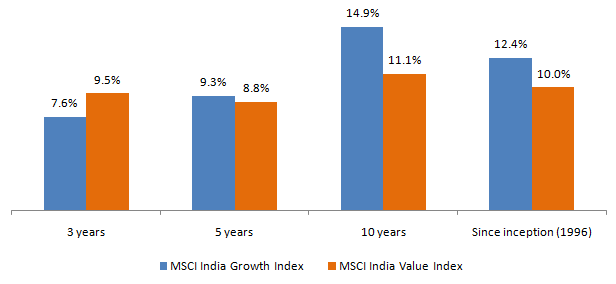Growth Fund versus Value Fund: Which mutual fund scheme should you have in your portfolio

Mutual fund investing is all about mapping your goals to suitable schemes that can help you achieve those goals. Your risk appetite and investment tenure are the two most important factors you’ll consider before you invest, as they determine your asset category allocations. But investment styles can also affect your returns from equity mutual funds.
So, what are investment styles, and how do you choose a fund based on it?
Investment style refers to the strategy used by the fund manager to select stocks for a mutual fund scheme. It can either be a growth oriented or value style. We will discuss these two styles in our blog post today and how it can play a role in your investment decisions. Please note that, there is a third investment style known as GARP (growth at reasonable price) which is outside the scope of today’s post.
Growth Investment Style
Fund managers who employ a growth investment style try to identify stocks of companies which will deliver high earnings per share growth over the next few quarters. When earnings of these companies increase, growth stocks exhibit a faster growth in share prices, and thereby faster capital appreciation. Investors should understand that investment styles are market cap and sector agnostic; and that the fund manager can identify growth stocks across different market cap segments and sectors.
Two general characteristics of growth stocks are a relatively higher P/E ratio and a relatively lower dividend yield (dividend paid by the stock divided by the market price of the stock) compared to value stocks. The P/E ratio of the MSCI India Growth Index (the index of large and midcap growth stocks in India) is 31.8 and the dividend yield is 0.79%. Growth stocks tend to rise faster in bull markets but also fall more in bear markets.
Value Investment Style
Fund managers who follow the value style try to identify stocks which are trading at a significant discount to their fair prices. Fair price is the intrinsic value of a stock based on its business fundamentals e.g. competitive strengths, market share, industry growth potential, company’s revenue growth prospects, margins, leverage (debt to equity ratio) etc.
The stock may trade at a price higher or lower than the fair valuation.If the market price of the stock is lower than the fair price, then the stock is under-valued and vice versa. In value investing, fund managers try to pick stocks which give them a high margin of safety. Investments in stocks which are trading at a significant discount to their fair price provide a margin of safety because the downside risk is limited. Two characteristics of value stocks are a lower P/E ratio and a higher dividend yield compared to growth stocks.The P/E ratio of MSCI India Value Index (the index of large and midcap value stocks in India) is 17.3 and the dividend yield is 1.83%.Value stocks may underperform growth stocks in bull markets but limit losses in bear markets. Also, the higher dividend yields in value stocks provide more stability in volatile markets compared to growth stocks.
Which style suits you more?
Your investment style preference should depend on your risk tolerance. You should be able to distinguish between risk appetite and risk tolerance. Risk tolerance refers to your emotional reaction to risk events, while risk appetite is your capacity to take risks. For example, you may have a long investment horizon and high risk appetite, but may feel jittery when the market crashes.
Both growth and value funds can produce good returns in the long term but their relative performance may change over different phases of investment cycles. As discussed earlier, growth funds may outperform in bull markets, while value funds may outperform in bear markets. If you are worried about volatility in your investment portfolio then value funds may be more suitable for you. On the other hand, if you are an experienced investor and have a high risk appetite, then growth funds can produce higher returns for you in a shorter time-frame.
Growth versus Value Fund Returns
Some investors may ask whether a growth investing style gives higher returns compared to value investing or vice versa in the long term. To look for an answer to this question, let us look at the annual returns of MSCI India Growth Index and MSCI India Value Index over the last 10 years.

Source: MSCI
You can see that growth stocks have generally underperformed in bear markets. In bull markets, growth funds have generally outperformed value funds. The chart above corroborates the observations made earlier about growth and value stock performances in different market cycles.
Let us now look at the returns of the MSCI India Growth Index and MSCI India Value Index over longer investment tenures. The definition of long term differs from one investor to another, depending on their personal views. In our view, investors need to have a minimum 3-year investment tenure for equity funds.
The chart below shows the annualized returns of MSCI India Growth Index and MSCI India Value Index over different time-scales e.g. 3 years, 5 years, 20 years etc.

Source: MSCI
You can see that in the 3-year time frame, value stocks have outperformed growth stocks. However, over longer tenures, growth stocks have outperformed value stocks. If you have a long investment tenure in mind, you have enough time for stocks to bounce back from their bear market lows and give you good returns.
Our take and conclusion
You might wonder whether these investment styles really matter in mutual fund selection.
For the average investor, if you select mutual funds with a good long-term track record and monitor their performance on a regular basis, it will not matter how you reach your investment goal. However, for more experienced and knowledgeable investors, having a mix of value and growth mutual funds in your portfolio will help you achieve better diversification. Different investment goals will have different time lines, and considering those and your risk appetite, you can choose between value and growth funds.
Suggested reading –
https://www.advisorkhoj.com/smf/did-you-know-the-basics-of-mutual-fund-investing
https://www.advisorkhoj.com/smf/what-are-equity-mutual-funds-in-india-and-their-types
https://www.advisorkhoj.com/smf/most-important-analytical-measures-for-selecting-best-mutual-funds
Mutual Fund Investments are subject to market risk, read all scheme related documents carefully.
RECOMMENDED READS
Sundaram Asset Management Company is the investment manager to Sundaram Mutual Fund. Founded 1996, Sundaram Mutual is a fully owned subsidiary of one of India's oldest NBFCs - Sundaram Finance Limited.
Quick Links
- Interview - Mr. Dwijendra Srivastava - CIO - Fixed Income
- Interview - Mr. Sunil Subramaniam - CEO
- Sundaram Select Midcap Fund: Consistent outperformance makes it a big wealth creator
- Interview - Mr. Sunil Subramaniam - CEO
- Fund Manager Interview - Mr. Krishna Kumar - CIO - Equities
- Sundaram Rural India Fund: This thematic Mutual Fund aiming good long term returns
- Sundaram Equity Multiplier: Long term wealth creation potential
- Our Articles
- Our Website
- SIP one sheeter-Investor Education initiative
- Sundaram Asset Management Singapore
- Returns Calculator
- SEBI Investor Awareness Initiative
- Check your KYC Status
- KYC Forms & FAQs
- Recieve your PIN
- A note on NIGO
- FAQs on RGESS
- FAQs on Direct Plan
- Receive Updates
- Share your views
- Transmission Checklist
- Equity Application Form
- Fixed Income Application Form
- Transaction Slip
- Factsheet May - 2016
- MF Tax Reckoner 2015
Follow Sundaram MF
More About Sundaram MF
POST A QUERY




